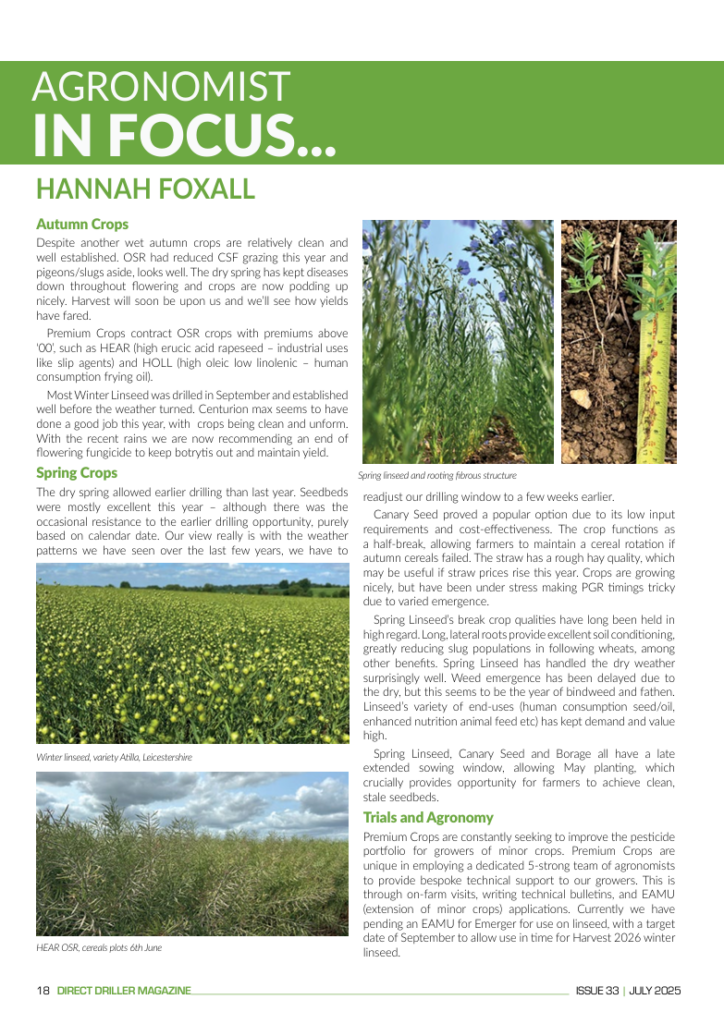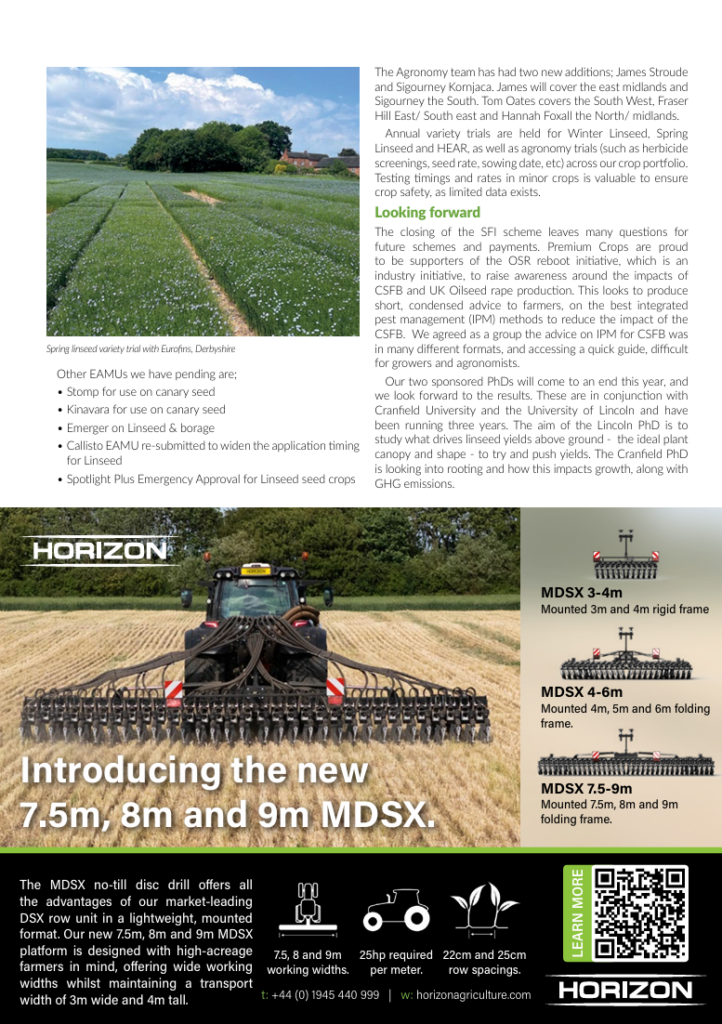Autumn Crops
Despite another wet autumn crops are relatively clean and well established. OSR had reduced CSF grazing this year and pigeons/slugs aside, looks well. The dry spring has kept diseases down throughout flowering and crops are now podding up nicely. Harvest will soon be upon us and we’ll see how yields have fared.
Premium Crops contract OSR crops with premiums above ‘00’, such as HEAR (high erucic acid rapeseed – industrial uses like slip agents) and HOLL (high oleic low linolenic – human consumption frying oil).
Most Winter Linseed was drilled in September and established well before the weather turned. Centurion max seems to have done a good job this year, with crops being clean and unform. With the recent rains we are now recommending an end of flowering fungicide to keep botrytis out and maintain yield.

Winter linseed, variety Atilla, Leicestershire

HEAR OSR, cereals plots 6th June
Spring Crops
The dry spring allowed earlier drilling than last year. Seedbeds were mostly excellent this year – although there was the occasional resistance to the earlier drilling opportunity, purely based on calendar date. Our view really is with the weather patterns we have seen over the last few years, we have to readjust our drilling window to a few weeks earlier.
Canary Seed proved a popular option due to its low input requirements and cost-effectiveness. The crop functions as a half-break, allowing farmers to maintain a cereal rotation if autumn cereals failed. The straw has a rough hay quality, which may be useful if straw prices rise this year. Crops are growing nicely, but have been under stress making PGR timings tricky due to varied emergence.
Spring Linseed’s break crop qualities have long been held in high regard. Long, lateral roots provide excellent soil conditioning, greatly reducing slug populations in following wheats, among other benefits. Spring Linseed has handled the dry weather surprisingly well. Weed emergence has been delayed due to the dry, but this seems to be the year of bindweed and fathen. Linseed’s variety of end-uses (human consumption seed/oil, enhanced nutrition animal feed etc) has kept demand and value high.
Spring Linseed, Canary Seed and Borage all have a late extended sowing window, allowing May planting, which crucially provides opportunity for farmers to achieve clean, stale seedbeds.


Spring linseed and rooting fibrous structure
Trials and Agronomy
Premium Crops are constantly seeking to improve the pesticide portfolio for growers of minor crops. Premium Crops are unique in employing a dedicated 5-strong team of agronomists to provide bespoke technical support to our growers. This is through on-farm visits, writing technical bulletins, and EAMU (extension of minor crops) applications. Currently we have pending an EAMU for Emerger for use on linseed, with a target date of September to allow use in time for Harvest 2026 winter linseed.
Other EAMUs we have pending are;
- Stomp for use on canary seed
- Kinavara for use on canary seed
- Emerger on Linseed & borage
- Callisto EAMU re-submitted to widen the application timing for Linseed
- Spotlight Plus Emergency Approval for Linseed seed crops
The Agronomy team has had two new additions; James Stroude and Sigourney Kornjaca. James will cover the east midlands and Sigourney the South. Tom Oates covers the South West, Fraser Hill East/ South east and Hannah Foxall the North/ midlands.
Annual variety trials are held for Winter Linseed, Spring Linseed and HEAR, as well as agronomy trials (such as herbicide screenings, seed rate, sowing date, etc) across our crop portfolio. Testing timings and rates in minor crops is valuable to ensure crop safety, as limited data exists.

Spring linseed variety trial with Eurofins, Derbyshire
Looking forward
The closing of the SFI scheme leaves many questions for future schemes and payments. Premium Crops are proud to be supporters of the OSR reboot initiative, which is an industry initiative, to raise awareness around the impacts of CSFB and UK Oilseed rape production. This looks to produce short, condensed advice to farmers, on the best integrated pest management (IPM) methods to reduce the impact of the CSFB. We agreed as a group the advice on IPM for CSFB was in many different formats, and accessing a quick guide, difficult for growers and agronomists.
Our two sponsored PhDs will come to an end this year, and we look forward to the results. These are in conjunction with Cranfield University and the University of Lincoln and have been running three years. The aim of the Lincoln PhD is to study what drives linseed yields above ground – the ideal plant canopy and shape – to try and push yields. The Cranfield PhD is looking into rooting and how this impacts growth, along with GHG emissions.

